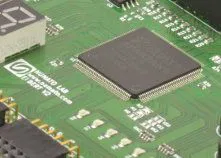Table of Contents:
The PCA9685 is an advanced PWM (Pulse Width Modulation) controller manufactured by NXP Semiconductors that has gained recognition among electronic system designers and hobbyists for its versatility and ease of implementation. The chip is used in a variety of applications, including robotics, lighting control and many others. All this makes it one of the more versatile components in this category.
Basic information and features of the PCA9685
The controller has 16 independent channels. Each is independently programmable, allowing the user to set any of 4096 PWM values for each channel. This configuration allows precise control of, among other things, servos where angle control is needed and LEDs where light intensity control is needed. The high 12-bit resolution allows for very smooth transitions of light intensity and motion. Such high sensitivity is essential for applications such as professional stage lighting and precision robotics.
The remote shutdown function allows all outputs to be quickly deactivated by the OE signal. This option is invaluable in emergency situations during system maintenance.
The PCA9685 can use an internal oscillator or an external clock source. This allows the user to tailor the PWM frequency to the specific needs of the application. In addition, the ability to synchronize the clock with other circuits in the system allows for more integrated and efficient power and signal management.
Electrical parameters of the controller
The supply voltage (VDD) of the PCA9685 controller ranges from 2.3 V to 5.5 V. These values allow for easy integration into most modern electronic systems. Other electrical parameters are as follows.
- The frequency can be set from very low values (about 24 Hz) to 1526 Hz. Such a wide range gives the user the ability to tailor the device to project requirements.
- Each PWM output is capable of handling up to 25 mA of current. This allows direct control of most LEDs. Additional current drivers are recommended for servos.
Construction of the PCA9685 controller
At the heart of the controller is the PCA9685 main IC. This is the central part of the controller, used to generate and manage PWM signals. Other components of the design are described below.
- The PWM PCA9685 has 16 independent PWM channels. This means that each channel can control one device.
- The next component is a voltage regulator. This component provides a stable power supply for the IC and the devices connected to it.
- The PCA9685 is controlled via a communication interface. In general, it is an I2C ( Inter-Integrated Circuit) interface, which allows easy communication with the microcontroller and other devices.
- The controller is equipped with connectors that allow the connection of external devices such as LEDs, DC motors and servos.
- The next components are smoothing capacitors that help stabilize the power supply and reduce noise, which is important for precise PWM control.
Other construction elements
The PCA9685 has a configuration register that allows you to set various operating parameters, such as PWM signal frequency, operating mode and current limit settings. The following are other components of the design.
- Some PCA9685 models are equipped with indicator LEDs that indicate the status of the device (e.g., operational readiness, communication activity and errors).
- The various versions of the PCA9685 have built-in thermal and overload protection. Their function is to protect the controller and connected devices from damage resulting from overheating or overloading.
Example projects using the PCA9685 controller
The PCA9685 is widely used in robotics because of its ability to control multiple servos from a single microcontroller. Here are some examples of robotics projects that can use this PWM controller
Robot manipulator
A robot manipulator with multiple joints, where each joint is driven by a servo. The use of the PCA9685 allows independent control of each servo, enabling precise movements and positioning of the robot arm. The controller facilitates the programming of complex motion sequences and improves the accuracy and repeatability of operations.
Educational robot
Educational robots are often used in schools to teach programming and robotics. Using the PCA9685 to control servos allows students to experiment with different control algorithms. In addition, students can easily test the effects of different control parameters on the robot’s behavior.
Four-legged robot (Quadrapod)
Another project is a four-legged robot that mimics the gait of animals. The use of the PCA9685 includes controlling the servos responsible for the movement of each leg. In practice, this means being able to perform natural and complex movements. The controller makes it easier for designers to create more advanced and efficient robot motion systems.
Automated vehicles
The next project is robotic vehicles used in logistics, warehouses or as educational platforms for learning autonomy. Applications of the PCA9685 include servo control for steering. This allows precise control of the vehicle’s direction and movement, which is crucial in autonomous navigation systems.
Interactive robots
Robots designed to interact with humans are often used in reception, customer service, or as assistants. Applications of the PCA9685 include controlling mechanical movements such as hand gestures and facial expressions. The controller enables the creation of more expressive and engaging robots, which improves their effectiveness in interactions with humans.
PCA9685 is a versatile PWM controller that has been widely used in electronic projects that require precise control of various devices. Thanks to its advanced features and flexibility, it is valued by hobbyist engineers and robotics developers.
How useful was this post?
Click on a star to rate it!
Average rating 0 / 5. Vote count: 0
No votes so far! Be the first to rate this post.





















